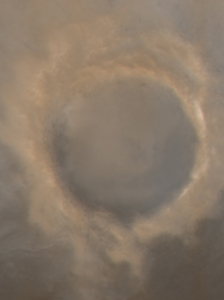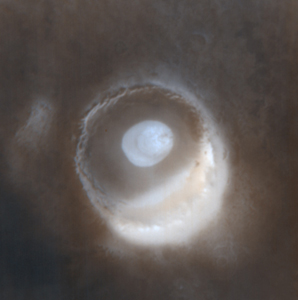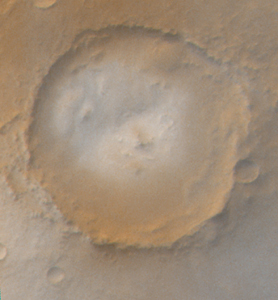
Mars Global Surveyor
Mars Orbiter Camera
The Frosted Craters of Northern Spring and Southern Autumn
MGS MOC Release No. MOC2-258, 27 November 2000
M0C2-258a, Northern Spring, 61°N, 9°W

Lomonosov Crater, August 12, 2000
--151 km (94 mi) across--
|
MOC2-258b, Northern Spring, 71°N, 257°W

Unnamed Crater, October 6, 2000
--48 km (30 mi) across--
|
M0C2-258c, Southern Autumn, 62°S, 298°W

Barnard Crater, August 15, 2000
--128 km (79 mi) across--
|
M0C2-258d, Southern Autumn, 52°S, 81°W

Lowell Crater, October 17, 2000
--201 km (125 mi) across--
|
The Mars Global Surveyor Mars Orbiter Camera (MOC) wide angle system is
used to monitor changes in martian weather and the seasonal coming
and going of polar frost. These four wide angle pictures of craters
in both the northern and southern middle and polar latitudes of Mars show
examples of frost monitoring conducted by the MOC in recent months.
It is spring in the northern hemisphere, and frost that accumulated
during the most recent 6-month-long winter has been retreating since
May. Examples of frost-rimmed craters include
Lomonosov (top, left) and an unnamed crater farther north (top, right).
The unnamed crater has a patch of frost on its floor that--based on how it
looked during the 1970s Viking missions--is expected to persist through summer.
It is autumn in the southern hemisphere, and frost was seen as early
as August in some craters, such as Barnard (bottom, left); later the
frost line moved farther north, and we began to see frost in Lowell
Crater (bottom, right) in mid-October.
For a view of what Lomonosov Crater looked like during northern winter, see
"The Frosty Rims of Lomonosov Crater in Winter."
Note: When you click on each picture, above, you will see it at the
full resolution obtained by MOC. Each image is a composite of two
pictures obtained at the same time,
a red wide angle view and a blue wide angle view. In each picture, north
is toward the top and sunlight illuminates the scene from the upper
left (for southern hemisphere) or lower left (for northern hemisphere).
Images Credit: NASA/JPL/Malin Space Science Systems
Malin Space Science Systems and the California Institute of
Technology built the MOC using spare hardware from the Mars Observer
mission. MSSS operates the camera from its facilities in San Diego,
CA. The Jet Propulsion Laboratory's Mars Surveyor Operations Project
operates the Mars Global Surveyor spacecraft with its industrial
partner, Lockheed Martin Astronautics, from facilities in Pasadena, CA
and Denver, CO.
 To MSSS Home Page
To MSSS Home Page

